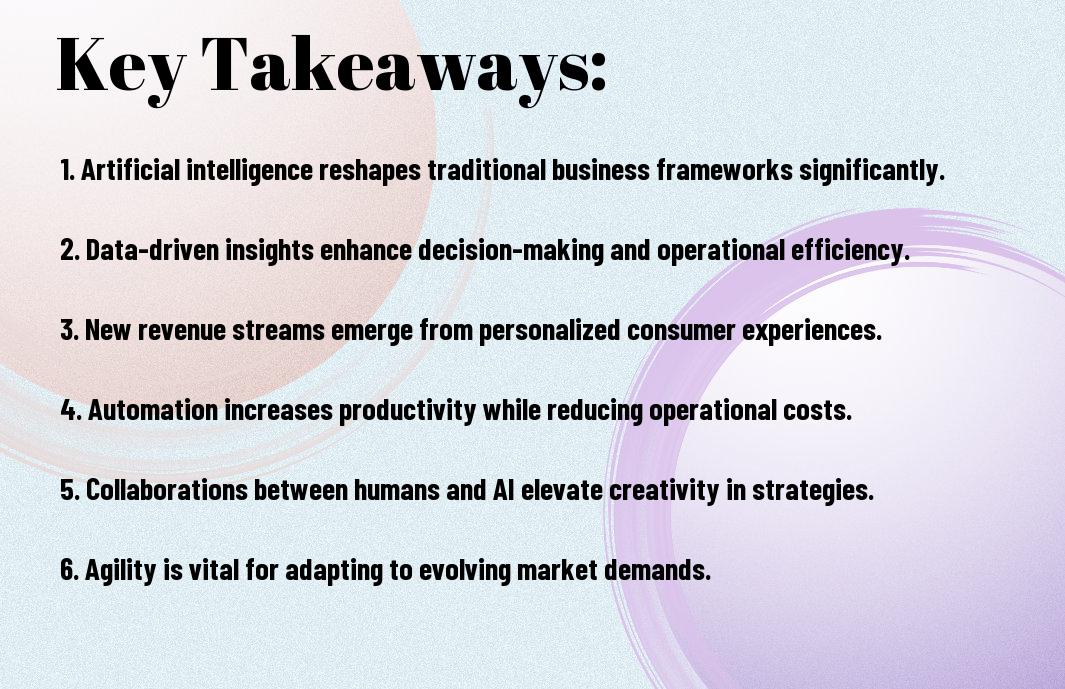As you navigate the ever-changing landscape of the digital age, you’re likely aware that artificial intelligence (AI) is transforming the way businesses operate. You may be wondering how to leverage AI to drive innovation and stay ahead of the competition. Your organization’s ability to adapt to this shift will be key to its success, and understanding the new business models enabled by AI is vital to making informed decisions about your company’s future. You will learn how to harness AI’s power.
Key Takeaways:
- The AI-driven revolution is transforming the business landscape by enabling companies to create new business models that are more efficient, agile, and customer-centric, leveraging technologies such as machine learning and natural language processing to drive innovation.
- Successful companies in the digital age will be those that can harness the power of AI to develop new revenue streams, improve operational efficiency, and enhance customer experiences, thereby gaining a competitive edge in the market.
- The integration of AI into business operations requires a fundamental shift in organizational culture, with a focus on data-driven decision-making, continuous learning, and collaboration between humans and machines to drive business outcomes.
- AI-driven business models can take many forms, including subscription-based services, freemium models, and data-as-a-service, allowing companies to monetize their data and intellectual property in new and innovative ways.
- As AI continues to evolve and improve, companies must prioritize ongoing investment in AI research and development, talent acquisition, and employee upskilling to stay ahead of the curve and capitalize on emerging opportunities in the digital age.

The Strategic Imperative of AI
The advent of AI is transforming the business landscape, and you must adapt to stay competitive. You will need to reassess your business models and strategies to leverage AI’s potential. Your ability to integrate AI into your operations will determine your success in the digital age.
Competitive Advantage Through Algorithmic Decision-Making
Above all, you should focus on developing algorithmic decision-making capabilities to drive your business forward. You can gain a competitive edge by using AI to analyze data, identify patterns, and make informed decisions. Your organization will become more agile and responsive to changing market conditions.
Value Chain Transformation
To fully harness the power of AI, you need to transform your value chain. You should identify areas where AI can streamline processes, improve efficiency, and reduce costs. Your value chain will become more resilient and better equipped to handle the challenges of the digital age.
Another key aspect of value chain transformation is the ability to create new revenue streams and business models. You can use AI to develop innovative products and services that meet the evolving needs of your customers. Your business will become more customer-centric, and you will be able to differentiate yourself from competitors. As you launch on this journey, you will discover new opportunities for growth and expansion.
Five Fundamental Business Models
Now that you’re exploring the AI-driven revolution, you’ll discover new opportunities for growth. You’ll find that these models are designed to help your business thrive in the digital age, leveraging AI to drive innovation and revenue.
AI-as-a-Service Providers
For instance, as you consider AI-as-a-Service providers, you’ll see how they offer scalable solutions, enabling your business to access AI capabilities without significant upfront investments, allowing you to focus on core operations.
Data Monetization Ecosystems
Business leaders like you are turning to data monetization ecosystems, which enable you to unlock the value of your data, creating new revenue streams and driving business growth through strategic partnerships and data-driven insights.
Ecosystems like these allow you to leverage your data assets, creating a competitive advantage in the market. You can develop targeted marketing campaigns, improve customer experiences, and drive innovation, all while maintaining control over your data and ensuring its security and integrity, which is vital for building trust with your customers and partners.
Cost Structure Realignment
Once again, you will need to reassess your business model as AI-driven technologies continue to advance, and this includes reevaluating your cost structure to remain competitive in the digital age.
Fixed to Variable Cost Shifting
Fixing your costs to variable expenses allows you to adapt to changing market conditions, and you can achieve this by adopting AI-driven solutions that reduce your fixed costs and increase your variable costs, enabling your business to scale more efficiently.
Scalability Economics
At the heart of AI-driven business models is the ability to scale quickly and efficiently, and you can achieve this by leveraging AI technologies that enable your business to grow without a corresponding increase in costs, allowing you to reap the benefits of scalability economics.
Realignment of your cost structure to take advantage of scalability economics will enable you to reduce your costs per unit as your business grows, and you can achieve this by investing in AI-driven technologies that automate processes, improve efficiency, and enable your business to scale quickly and efficiently, allowing you to stay competitive in the digital age and increase your profitability.
Market Entry Strategies
To succeed in the AI-driven revolution, you need to develop effective market entry strategies that set your business up for success. Your approach will depend on your goals, resources, and target market.
First-Mover Positioning
Entering a new market first can give you a competitive edge, allowing you to establish your brand and capture market share before others follow. Your early mover advantage can help you shape the market and influence consumer behavior.
Strategic Partnerships and Acquisitions
On the other hand, forming strategic partnerships or acquiring existing businesses can provide a faster and more cost-effective way to enter a new market. Your partnerships can bring new technologies, expertise, and customer bases to your business.
But as you explore strategic partnerships and acquisitions, you should carefully evaluate the potential benefits and risks, considering factors such as cultural fit, financial performance, and regulatory compliance. You will need to assess how these partnerships and acquisitions align with your overall business strategy and goals, and ensure that you have the necessary resources and expertise to integrate them successfully into your operations.

Organizational Architecture
After establishing your AI-driven business model, you need to design an organizational architecture that supports its implementation, enabling you to leverage technology and data to drive growth and innovation, and you must consider how your organization’s structure and processes will be impacted.
Talent Requirements and Knowledge Management
To effectively manage your AI-driven business, you will need to assess your talent requirements and develop a knowledge management strategy that ensures your team has the necessary skills and expertise to succeed in the digital age, and you should prioritize ongoing learning and development.
Governance Frameworks
Above all, you must establish governance frameworks that ensure accountability, transparency, and ethics in your AI-driven decision-making processes, and you should define clear roles and responsibilities for your team members, and you will need to establish a framework that ensures compliance with regulatory requirements.
Knowledge of governance frameworks is necessary for you to develop a comprehensive approach to managing your AI-driven business, and you should consider factors such as data privacy, security, and intellectual property protection when designing your governance framework, and you must ensure that your framework is flexible and adaptable to evolving regulatory requirements and technological advancements.
Measuring AI-Driven Performance
Unlike traditional business models, AI-driven performance requires a new set of metrics. You can learn more about How the Rise of AI Drives New Business Models and discover the latest trends in AI adoption.
Key Performance Indicators
Monitoring your AI-driven performance involves tracking key metrics that matter to your business. You will need to identify the most relevant indicators to measure the success of your AI initiatives.
Return on AI Investment Metrics
For your AI investments to pay off, you need to measure their impact on your bottom line. You should focus on metrics that show the direct financial benefits of your AI initiatives.
In addition, to get the most out of your AI investments, you will need to consider metrics such as customer acquisition costs, customer lifetime value, and revenue growth, which can help you evaluate the effectiveness of your AI-driven business models and make data-driven decisions to optimize your strategies.
Conclusion
So, as you commence on this journey of the AI-driven revolution, you will discover new business models that transform your operations and unlock unprecedented opportunities. You will leverage AI to create innovative products, services, and experiences that meet evolving customer needs. By embracing this digital age, you will stay ahead of the curve and drive your business forward, leveraging the power of AI to achieve your goals and succeed in a rapidly changing landscape. Your ability to adapt will be key to your success.
FAQ
Q: What is the main driving force behind the AI-driven revolution in the digital age?
A: The main driving force behind the AI-driven revolution is the rapid advancement and accessibility of artificial intelligence technologies. This has enabled businesses to leverage AI to automate processes, enhance customer experiences, and develop new business models that were previously unimaginable. As AI continues to evolve, it is transforming industries and creating new opportunities for innovation and growth.
Q: How are new business models emerging in the digital age as a result of AI-driven revolution?
A: New business models are emerging in various forms, including subscription-based services, data-as-a-service, and platform-based economies. For instance, companies are using AI to offer personalized products and services, creating new revenue streams and disrupting traditional industries. Additionally, AI-driven automation is enabling businesses to reduce costs and improve efficiency, allowing them to focus on high-value tasks and create new business opportunities. The AI-driven revolution is also giving rise to new forms of entrepreneurship and innovation, as startups and established companies alike are using AI to develop novel solutions and business models.
Q: What skills and strategies do businesses need to adopt to thrive in the AI-driven digital age?
A: To thrive in the AI-driven digital age, businesses need to adopt a range of skills and strategies. These include developing a deep understanding of AI technologies and their applications, investing in data analytics and digital infrastructure, and fostering a culture of innovation and experimentation. Businesses also need to develop strategies for managing and mitigating the risks associated with AI, such as job displacement and bias in decision-making. Furthermore, they need to prioritize continuous learning and upskilling, as the AI-driven revolution is creating new job categories and requiring workers to develop new skills to remain relevant in the digital economy.



